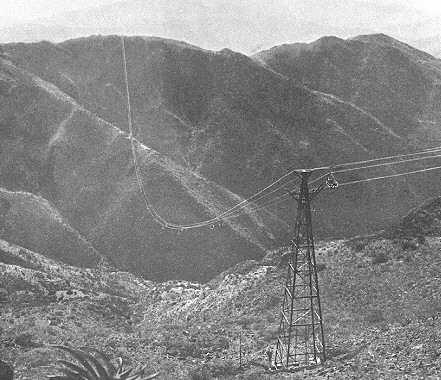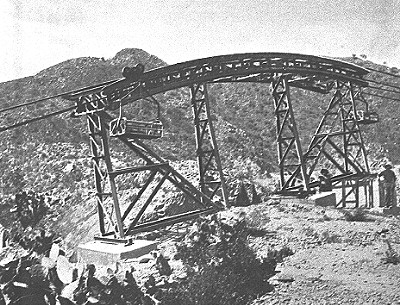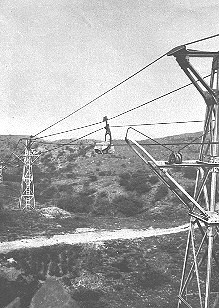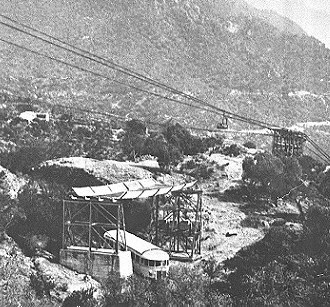This website has been archived from TrainWeb.org/italeritrea to TrainWeb.US/italeritrea.
Introduction / System Description / What Happened / Home pageThe System
 In this three-cable system, two cables supported the cars and
another moved them. The supporting cables, one for supporting each
direction of movement, were attached to counterweights at their
ends to maintain a set tension no matter what weight they were
carrying. The other cable, a giant loop, was attached at one end
to the pulling motor and at the other end to a counterweight to
maintain tension. The steel supporting cables were 30 mm (1.2 in.)
in diameter. The pulling cable was a three-strand steel cable with
a hemp core.
In this three-cable system, two cables supported the cars and
another moved them. The supporting cables, one for supporting each
direction of movement, were attached to counterweights at their
ends to maintain a set tension no matter what weight they were
carrying. The other cable, a giant loop, was attached at one end
to the pulling motor and at the other end to a counterweight to
maintain tension. The steel supporting cables were 30 mm (1.2 in.)
in diameter. The pulling cable was a three-strand steel cable with
a hemp core.
Because obviously no cable could span the whole 75 km (46.5 mi.) of the route, the resulting tramway was actually made up of thirty linked sections, each with its own supporting and pulling cables. But this fact did not prevent some mighty long and spectacular spans in the mountainous portion of the route. One span just over the escarpment from Godaif at Mt Codemas shown here (and in the opening picture from the opposite side) spans a full kilometer (.62 mi.) while several others come close to this distance.
 |
 Simple Towers |
 |
 and Towers with Dual Counterweights |
About 500 towers supported the cables. Simple towers held the cables and cars as the tramway crossed relatively level ground where there were no abrupt changes in angles. When the tramway crossed steep ridges multiple towers provided a uniform change in direction. At the end of the cable sections deep pits held counterweights while special towers provided the mechanisms for moving the cars from one set of carrying cables and pulling cable to the next.
Where the tramway crossed over the railway, they built protective covers over the railway so materials falling from the tramway cars would not damage any train or littorina passing below.
 Seven 150 horsepower Tosi diesel engines and one 75 horsepower Tosi
diesel engine provided the power to run the tramway. A telephone
system provided communications between all stations and between the
cars and the stations allowing for both routine communications and
emergency shutdown quickly.
Seven 150 horsepower Tosi diesel engines and one 75 horsepower Tosi
diesel engine provided the power to run the tramway. A telephone
system provided communications between all stations and between the
cars and the stations allowing for both routine communications and
emergency shutdown quickly.
The cars were held to the cables by a mechanism that allowed the workers in the Nefasit and Ghinda stations and Asmara, Campo de Marte, and munitions terminals to remove and attach the cars without stopping the tramway. Each car could hold about 300 kg (660 lbs.) and could be covered to keep out the elements. When operating at full capacity, the tramway could support about 1520 cars at once. To say this another way, at capacity the tramway was able to deliver 30 metric tons (33 US tons) of goods an hour, 24 hours a day.
Introduction /
System Description /
What Happened /
Home page
Copyright © 2000 Mike Metras, www.WorksAndWords.com














